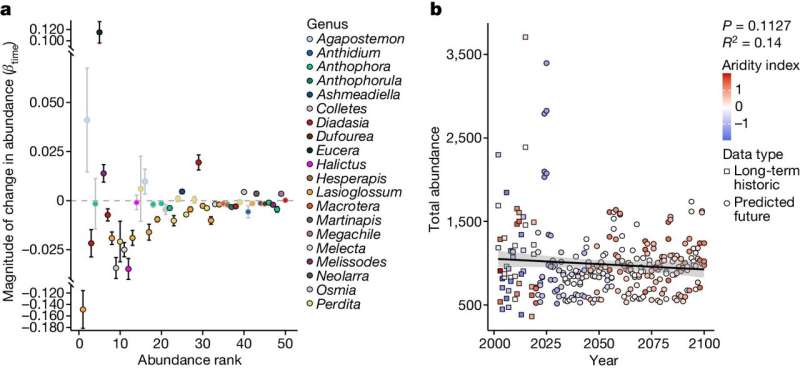This article has been reviewed according to Science X's editorial process and policies. Editors have highlighted the following attributes while ensuring the content's credibility:
fact-checked
peer-reviewed publication
trusted source
proofread
Heat and desiccation tolerances predict bee abundance under climate change

Recent research by the University of New Mexico alumnus Melanie Kazenel and colleagues predicts climate change will reshape bee communities in the southwest United States, with some thriving and others declining. The research, titled "Heat and desiccation tolerances predict bee abundance under climate change," was recently published in Nature.
Kazenel completed her Ph.D. in Biology at UNM in 2022 and is currently a visiting assistant professor of Biology at Earlham College in Indiana.
"I study how native bees are responding to climate change," Kazenel said. "Bees are the most important pollinators of many wild plants and agricultural crops, meaning that they are crucial to sustaining natural ecosystems and the human food supply. But there is increasing evidence that bees are threatened globally.
"Factors known to threaten bees include habitat loss, pesticides, disease, and climate change. However, climate change has been less-studied relative to other factors that threaten bees.
"Our research sought to fill this important knowledge gap. In particular, in the southwestern US, the climate is becoming warmer and drier over time, as well as more variable from year to year. We aimed to understand how these changes impact bee communities in our region."
The research was conducted at the Sevilleta National Wildlife Refuge (SNWR) near Socorro, N.M., as part of the Sevilleta Long-Term Ecological Research Program (SEV-LTER).
"This region is home to extraordinarily high bee diversity. We have recorded about 340 species of wild, native bees at the SNWR alone," Kazenel said.
The research began in 2002, when UNM Adjunct Assistant Professor of Biology Karen W. Wright established a long-term bee monitoring study at the SEV-LTER. This study, which is still ongoing, is possibly the world's longest continuous bee monitoring effort.
"Each month from March through October, when bees are active, we open traps in the field at the SNWR to collect bees, which we then identify to species. This gives us an incredible record of how bee abundance and diversity have changed from month-to-month and year-to-year over time. We have been able to pair our long-term bee data with data from on-site weather stations to understand how changes in bee abundance and diversity correspond with climate," Kazenel said.
To complement the long-term bee monitoring data, the researchers collected additional data on bee body size and physiology, taking body size measurements on preserved bee specimens collected in the long-term study. To collect physiology data, they netted bees in the field and placed them in an environmental chamber that allowed them to measure thermal (heat) tolerance and desiccation tolerance (tolerance to dry conditions).
"These data allowed us to determine whether body size and physiology relate to bee population trends," Kazenel explained. "For instance, are large-bodied or small-bodied bees more likely to be in decline? Are bee species with low tolerance of heat and desiccation more likely to be in decline? These data can help us understand which bee species are most threatened by climate change, and why."
The research revealed strong evidence that climate change is reshaping bee communities in the southwestern U.S.
"Climate was a strong predictor of bee population dynamics in our study: for 71% of populations, aridity, or the level of drought, predicted abundance. Some bees—those with high tolerance of heat and desiccation in our experiments—appear resilient to climate change and may even increase in abundance in the future. But our models forecast declines for 46% of species and predict more homogeneous future bee communities."
This is a concerning result, Kazenel said, as bee diversity supports diverse, healthy plant communities.
"We also found that larger-bodied bees dominated communities under the arid conditions that will increase in the future. Change in the body size composition of bee communities could alter pollination of plants, because the size of a bee and a flower need to 'match' for effective pollination to occur. Our study therefore provides important new evidence of how climate change is directly affecting bee communities and the plants they pollinate," she said.
"Our work paints a mixed picture about the future of bees in New Mexico," Kazenel summarized. "On one hand, some bee species appear well-adapted to persist under climate change, which gives us reason for hope. But on the other hand, we predict declines for nearly half of species, which is reason for great concern.
"Our work thus broadly speaks to the importance of swift action to curtail greenhouse gas emissions and mitigate future climate change to conserve the biodiversity that sustains our planet."
Co-authors on the study are Wright and Terry Griswold, research entomologist at the USDA-ARS Pollinating Insects Research Unit at Utah State University, both expert bee taxonomists who identified all bees collected in the study. "An enormous task because of the high species diversity in our region," Kazenel noted. Wright received her Ph.D. in Biology from UNM and now works for the Washington State Department of Agriculture.
The team also includes UNM Distinguished Professor of Biology Jennifer Rudgers and Professor Kenneth Whitney, associate chair of the UNM Department of Biology, who supervised the work, along with numerous field and lab assistants.
"This research has truly been a team effort," Kazenel noted.
Kazenel and other researchers at the SEV-LTER are continuing to study climate change effects on bees. In particular, they are working to document which plants are pollinated by each bee species in the dataset, allowing them to understand in more detail how changes in bee abundance under climate change will influence particular plant species. They are also exploring how changes in bee and plant phenology—the timing of life cycle events—could shift under climate change.
More information: Melanie R. Kazenel et al, Heat and desiccation tolerances predict bee abundance under climate change, Nature (2024). DOI: 10.1038/s41586-024-07241-2
Journal information: Nature
Provided by University of New Mexico




















